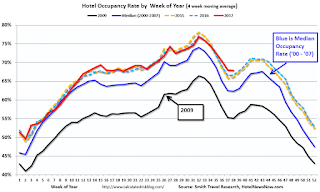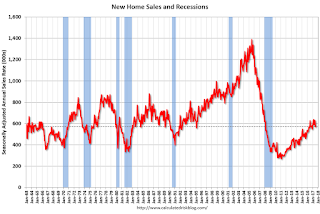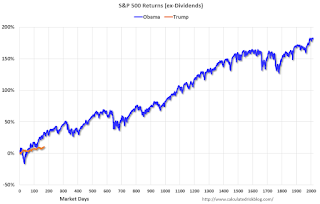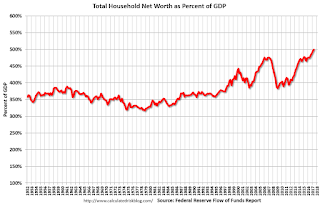by Calculated Risk on 9/24/2017 08:50:00 PM
Sunday, September 24, 2017
Sunday Night Futures
Weekend:
• Schedule for Week of Sept 24, 2017
Monday:
• At 8:30 AM ET, Chicago Fed National Activity Index for August. This is a composite index of other data.
• At 10:30 AM, Dallas Fed Survey of Manufacturing Activity for September.
From CNBC: Pre-Market Data and Bloomberg futures: S&P 500 are up 3, and DOW futures are up 35 (fair value).
Oil prices were up over the last week with WTI futures at $50.60 per barrel and Brent at $56.83 per barrel. A year ago, WTI was at $45, and Brent was at $47 - so oil prices are up 10% to 20% year-over-year.
Here is a graph from Gasbuddy.com for nationwide gasoline prices. Nationally prices are at $2.55 per gallon - up sharply due to Hurricane Harvey, but now declining - a year ago prices were at $2.20 per gallon - so gasoline prices are up 35 cents per gallon year-over-year.
Hotel Occupancy Rate just Behind Record Year
by Calculated Risk on 9/24/2017 11:00:00 AM
From HotelNewsNow.com: STR: US hotel results for week ending 16 September
The U.S. hotel industry reported positive year-over-year results in the three key performance metrics during the week of 10-16 September 2017, according to data from STR.The following graph shows the seasonal pattern for the hotel occupancy rate using the four week average.
In comparison with the week of 11-17 September 2016, the industry recorded the following:
• Occupancy: +0.5% to 72.2%
• Average daily rate (ADR): +1.4% to US$131.50
• Revenue per available room (RevPAR): +1.8% to US$94.97
Among the Top 25 Markets, Houston, Texas, reported the largest year-over-year increases in occupancy (+43.3% to 87.8%) and RevPAR (+58.6% to US$103.24). Amid recovery from Hurricane Harvey, Houston also posted an ADR increase of 10.7% to US$117.63.
Tampa/St. Petersburg, Florida, posted the second-highest lift in occupancy (+13.8% to 70.3%), that coupled with the highest increase in ADR (+14.1% to US$119.06), led the second-largest jump in RevPAR (+29.9% to US$83.75).
emphasis added
 The red line is for 2017, dash light blue is 2016, dashed orange is 2015 (best year on record), blue is the median, and black is for 2009 (the worst year since the Great Depression for hotels).
The red line is for 2017, dash light blue is 2016, dashed orange is 2015 (best year on record), blue is the median, and black is for 2009 (the worst year since the Great Depression for hotels).Currently the occupancy rate, to date, is ahead of last year, and just behind the record year in 2015. The hurricanes might push the annual occupancy rate to a new record.
Seasonally, the occupancy rate will increase into the Fall business travel season.
Data Source: STR, Courtesy of HotelNewsNow.com
Saturday, September 23, 2017
Schedule for Week of Sept 24, 2017
by Calculated Risk on 9/23/2017 08:09:00 AM
The key economic report this week is New Home sales for August on Tuesday.
Other key indicators include the third estimate of Q2 GDP, and July Case-Shiller house prices.
8:30 AM ET: Chicago Fed National Activity Index for August. This is a composite index of other data.
10:30 AM: Dallas Fed Survey of Manufacturing Activity for September.
 9:00 AM ET: S&P/Case-Shiller House Price Index for July.
9:00 AM ET: S&P/Case-Shiller House Price Index for July.This graph shows the nominal seasonally adjusted National Index, Composite 10 and Composite 20 indexes through the June 2017 report (the Composite 20 was started in January 2000).
The consensus is for a 5.9% year-over-year increase in the Comp 20 index for July.
Early: Reis Q3 2017 Apartment Survey of rents and vacancy rates.
 10:00 AM ET: New Home Sales for August from the Census Bureau.
10:00 AM ET: New Home Sales for August from the Census Bureau. This graph shows New Home Sales since 1963. The dashed line is the July sales rate.
The consensus is for 583 thousand SAAR, unchanged from 571 thousand in July.
10:00 AM: Richmond Fed Survey of Manufacturing Activity for September.
12:45 PM: Speech by Fed Chair Janet Yellen, Inflation, Uncertainty, and Monetary Policy, 59th NABE Annual Meeting, Cleveland, Ohio
7:00 AM ET: The Mortgage Bankers Association (MBA) will release the results for the mortgage purchase applications index.
8:30 AM: Durable Goods Orders for August from the Census Bureau. The consensus is for a 1.5% increase in durable goods orders.
10:00 AM: Pending Home Sales Index for August. The consensus is for a 0.1% decrease in the index.
8:30 AM ET: The initial weekly unemployment claims report will be released. The consensus is for 270 thousand initial claims, up from 259 thousand the previous week.
8:30 AM: Gross Domestic Product, 2nd quarter 2017 (Third estimate). The consensus is that real GDP increased 3.1% annualized in Q2, up from second estimate of 3.0%.
11:00 AM: the Kansas City Fed manufacturing survey for September.
Early: Reis Q3 2017 Office Survey of rents and vacancy rates.
8:30 AM: Personal Income and Outlays for August. The consensus is for a 0.3% increase in personal income, and for a 0.1% increase in personal spending. And for the Core PCE price index to increase 0.2%.
9:45 AM: Chicago Purchasing Managers Index for September. The consensus is for a reading of 58.6, down from 58.9 in August.
10:00 AM: University of Michigan's Consumer sentiment index (final for September). The consensus is for a reading of 97.2, unchanged from the preliminary reading 97.6.
Friday, September 22, 2017
Vehicle Forecast: Sales Expected to Exceed 17 million SAAR in September
by Calculated Risk on 9/22/2017 02:56:00 PM
The automakers will report September vehicle sales on Tuesday, October 3rd.
Note: There were 26 selling days in September 2017, there were 25 in September 2016.
From WardsAuto: Forecast: SAAR Expected to Surpass 17 Million in September
A WardsAuto forecast calls for U.S. light-vehicle sales to reach a 17.5 million-unit seasonally adjusted annual rate in September, following August’s 16.0 million SAAR and ending a 6-month streak of sub-17 million figures. In same-month 2016, the SAAR reached 17.6 million.Sales have been below 17 million SAAR for six consecutive months.
...
Preliminary assumptions pointed to October, rather than September, as the turning point for the market, as consumers replace vehicles lost due to natural disasters and automakers push sales to clear out excess model-year ’17 stock. However, the winds have already begun to turn, and September sales will be significantly higher than originally expected.
emphasis added
Mortgage Equity Withdrawal slightly positive in Q2
by Calculated Risk on 9/22/2017 10:23:00 AM
Note: This is not Mortgage Equity Withdrawal (MEW) data from the Fed. The last MEW data from Fed economist Dr. Kennedy was for Q4 2008.
The following data is calculated from the Fed's Flow of Funds data (released yesterday) and the BEA supplement data on single family structure investment. This is an aggregate number, and is a combination of homeowners extracting equity - hence the name "MEW" - and normal principal payments and debt cancellation (modifications, short sales, and foreclosures).
For Q2 2017, the Net Equity Extraction was a positive $12 billion, or a positive 0.3% of Disposable Personal Income (DPI) .

This graph shows the net equity extraction, or mortgage equity withdrawal (MEW), results, using the Flow of Funds (and BEA data) compared to the Kennedy-Greenspan method.
Note: This data is impacted by debt cancellation and foreclosures, but much less than a few years ago.
The Fed's Flow of Funds report showed that the amount of mortgage debt outstanding increased by $64 billion in Q2.
The Flow of Funds report also showed that Mortgage debt has declined by $1.23 trillion since the peak. This decline is mostly because of debt cancellation per foreclosures and short sales, and some from modifications. There has also been some reduction in mortgage debt as homeowners paid down their mortgages so they could refinance.
With a slower rate of debt cancellation, MEW will likely be mostly positive going forward.
For reference:
Dr. James Kennedy also has a simple method for calculating equity extraction: "A Simple Method for Estimating Gross Equity Extracted from Housing Wealth". Here is a companion spread sheet (the above uses my simple method).
For those interested in the last Kennedy data included in the graph, the spreadsheet from the Fed is available here.
Update: For Fun, Stock Market as Barometer of Policy Success
by Calculated Risk on 9/22/2017 08:11:00 AM
Note: This is a repeat of a June post with updated statistics and graph.
There are a number of observers who think the stock market is the key barometer of policy success. My view is there are many measures of success - and that the economy needs to work well for a majority of the people - not just stock investors.
However, for example, Treasury Secretary Steven Mnuchin was on CNBC on Feb 22, 2017, and was asked if the stock market rally was a vote of confidence in the new administration, he replied: "Absolutely, this is a mark-to-market business, and you see what the market thinks."
And Larry Kudlow wrote in 2007: A Stock Market Vote of Confidence for Bush: "I have long believed that stock markets are the best barometer of the health, wealth and security of a nation. And today's stock market message is an unmistakable vote of confidence for the president."
Note: Kudlow's comments were made a few months before the market started selling off in the Great Recession. For more on Kudlow, see: Larry Kudlow is usually wrong
For fun, here is a graph comparing S&P500 returns (ex-dividends) under Presidents Trump and Obama:

Blue is for Mr. Obama, Orange is for Mr. Trump.
At this point, the S&P500 is up 10.1% under Mr. Trump compared to up 32.2% under Mr. Obama for the same number of market days.
Thursday, September 21, 2017
Earlier: Philly Fed Manufacturing Survey "Showed Improvement" in September
by Calculated Risk on 9/21/2017 03:00:00 PM
Earlier from the Philly Fed: September 2017 Manufacturing Business Outlook Survey
Manufacturing firms reported an improvement in regional manufacturing conditions in September. The survey’s current indicators for general activity, new orders, and shipments increased this month and suggest a broadening of growth. Price pressures also picked up, according to the reporting firms. The survey’s future indicators suggest that manufacturers have generally grown more optimistic over the past three months.Here is a graph comparing the regional Fed surveys and the ISM manufacturing index:
...
The indexes for general activity [increased to 23.8 from 18.9 in August], new orders, and shipments increased this month, and employment remained positive.
emphasis added
 Click on graph for larger image.
Click on graph for larger image.The New York and Philly Fed surveys are averaged together (yellow, through September), and five Fed surveys are averaged (blue, through August) including New York, Philly, Richmond, Dallas and Kansas City. The Institute for Supply Management (ISM) PMI (red) is through August (right axis).
This suggests the ISM manufacturing index will show solid expansion in September.
Fed's Flow of Funds: Household Net Worth increased in Q2
by Calculated Risk on 9/21/2017 01:10:00 PM
The Federal Reserve released the Q2 2017 Flow of Funds report today: Flow of Funds.
According to the Fed, household net worth increased in Q2 2017 compared to Q1 2017:
The net worth of households and nonprofits rose to $96.2 trillion during the second quarter of 2017. The value of directly and indirectly held corporate equities increased $1.1 trillion and the value of real estate increased $0.6 trillion.The Fed estimated that the value of household real estate increased to $23.8 trillion in Q2. The value of household real estate is now above the bubble peak in early 2006 - but not adjusted for inflation, and this also includes new construction.
 Click on graph for larger image.
Click on graph for larger image.The first graph shows Households and Nonprofit net worth as a percent of GDP. Household net worth, as a percent of GDP, is higher than the peak in 2006 (housing bubble), and above the stock bubble peak.
This includes real estate and financial assets (stocks, bonds, pension reserves, deposits, etc) net of liabilities (mostly mortgages). Note that this does NOT include public debt obligations.
 This graph shows homeowner percent equity since 1952.
This graph shows homeowner percent equity since 1952. Household percent equity (as measured by the Fed) collapsed when house prices fell sharply in 2007 and 2008.
In Q2 2017, household percent equity (of household real estate) was at 58.4% - up from Q2, and the highest since Q1 2006. This was because of an increase in house prices in Q2 (the Fed uses CoreLogic).
Note: about 30.3% of owner occupied households had no mortgage debt as of April 2010. So the approximately 50+ million households with mortgages have far less than 58.4% equity - and about 2.8 million homeowners still have negative equity.
 The third graph shows household real estate assets and mortgage debt as a percent of GDP.
The third graph shows household real estate assets and mortgage debt as a percent of GDP. Mortgage debt increased by $64 billion in Q2.
Mortgage debt has declined by $1.23 trillion from the peak. Studies suggest most of the decline in debt has been because of foreclosures (or short sales), but some of the decline is from homeowners paying down debt (sometimes so they can refinance at better rates).
The value of real estate, as a percent of GDP, was up in Q2, and is above the average of the last 30 years (excluding bubble). However, mortgage debt as a percent of GDP, continues to decline.
Black Knight: Mortgage Delinquencies increase in Hurricane Affected Areas
by Calculated Risk on 9/21/2017 09:58:00 AM
• Nationally, delinquencies remained relatively flat from July, while delinquencies in Hurricane Harvey- impacted areas rose by 16 percent month over monthAccording to Black Knight's First Look report for August, the percent of loans delinquent increased 0.7% in August compared to July, and declined 7.3% year-over-year.
• Despite most payments being due August 1, and the storm making landfall near the end of the month, its effect on mortgage delinquencies is already being felt
• Over 6,700 new 30-day delinquencies can be attributed to Harvey, while an additional 1,000 borrowers who were already 30-days past due missed an additional mortgage payment in August as a result of the storm
• Based on observations from previous hurricanes, the heaviest impact on mortgage delinquency rates will come in September
The percent of loans in the foreclosure process declined 3.3% in August and were down 27.2% over the last year.
Black Knight reported the U.S. mortgage delinquency rate (loans 30 or more days past due, but not in foreclosure) was 3.93% in August, up from 3.90% in July.
The percent of loans in the foreclosure process declined in August to 0.76%.
The number of delinquent properties, but not in foreclosure, is down 148,000 properties year-over-year, and the number of properties in the foreclosure process is down 142,000 properties year-over-year.
| Black Knight: Percent Loans Delinquent and in Foreclosure Process | ||||
|---|---|---|---|---|
| Aug 2017 | July 2017 | Aug 2016 | Aug 2015 | |
| Delinquent | 3.93% | 3.90% | 4.24% | 4.87% |
| In Foreclosure | 0.76% | 0.78% | 1.04% | 1.48% |
| Number of properties: | ||||
| Number of properties that are delinquent, but not in foreclosure: | 2,003,000 | 1,986,000 | 2,151,000 | 2,413,000 |
| Number of properties in foreclosure pre-sale inventory: | 385,000 | 398,000 | 527,000 | 748,000 |
| Total Properties | 2,388,000 | 2,384,000 | 2,678,000 | 3,161,000 |
CoreLogic: "2.8 million Homes still in negative equity" at end of Q2 2017
by Calculated Risk on 9/21/2017 08:46:00 AM
From CoreLogic: CoreLogic Reports 2.8 Million Residential Properties with a Mortgage Still in Negative Equity
CoreLogic® ... today released its Q2 2017 home equity analysis which shows U.S. homeowners with mortgages (roughly 63 percent of all homeowners) have seen their equity increase by a total of 10.6 percent year over year, representing a gain of $766 billion since Q2 2016.
Additionally, homeowners gained an average of $12,987 in equity between Q2 2016 and Q2 2017. Western states led the equity increase with Washington homeowners gaining an average of approximately $40,000 in home equity and California homeowners gaining an average of approximately $30,000 in home equity. Home price increases in these states drove the equity gains.
From Q1 2017 to Q2 2017, the total number of mortgaged residential properties with negative equity decreased 10 percent to 2.8 million homes, or 5.4 percent of all mortgaged properties. Year over year, negative equity decreased 21.9 percent from 3.6 million homes, or 7.1 percent of all mortgaged properties, from Q2 2016 to Q2 2017.
“Over the last 12 months, approximately 750,000 borrowers achieved positive equity,” said Dr. Frank Nothaft, chief economist for CoreLogic. “This means that mortgage risk continues to decline and, given the continued strength in home prices, CoreLogic expects home equity to rise steadily over the next year.”
emphasis added
 Click on graph for larger image.
Click on graph for larger image.This graph shows the distribution of home equity in Q2 2017 compared to Q1 2017.
For reference, about five years ago, in Q3 2012, almost 10% of residential properties had 25% or more negative equity.
A year ago, in Q2 2016, there were 3.6 million properties with negative equity - now there are 2.8 million. A significant change.


